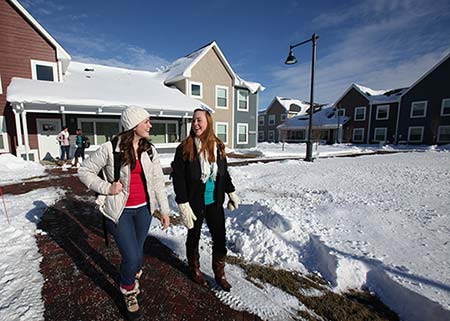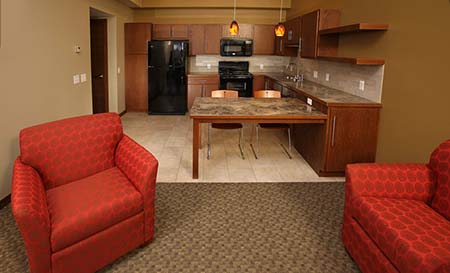Going platinum: Centennial Commons townhomes given top green rating by USGBC
January 30, 2013

Students walk to class from Centennial Commons on a winter day.

The inside of one of the Centennial Commons townhomes. The residential community has been awarded LEED Platinum Certification.
The first month of 2013 is ringing in with two "firsts" for the College of Saint Benedict.
Centennial Commons townhomes, a 125-person student housing development on the campus of CSB, has been awarded LEED® (Leadership in Energy and Environmental Design) for Homes Platinum, the highest level of certification given by the U.S. Green Building Council.
It is the first college student housing in Minnesota to reach this achievement and it is also the first building on CSB's campus to achieve any level of LEED certification.
"This is incredibly exciting news," said Jody Terhaar, CSB dean of students and coordinator for the Centennial Commons project. "It affirms the many decisions we made along the way to provide an outstanding student housing experience and also, ultimately, reflects our sustainability goals."
The certification is for the 32 townhomes located in four buildings off of College Avenue, across from the main CSB campus, which opened in August 2012.
CSB is seeking an additional certification for the Commons building on the property in a separate LEED New Construction category. The Commons building is shared by the residents and the broader CSB community.
"It was important for us to do this because we are able to put a sustainable approach into practice and reduce our environmental impact," added Judy Purman, CSB director of sustainability. "It's also a wonderful teaching example, not only for our students, but the wider community."
The complex was built to a 100-year life and the design engineering is as efficient as possible and includes high-efficiency windows and furnaces, natural daylight harvesting, on-demand water heaters, low-flow plumbing and exterior LED light fixtures.
Other sustainable features of Centennial Commons include:
- Townhomes were clustered (compact development) and extensive community resources are available within a half-mile including a library, fitness center, convenience store, church and shops.
- Building site is not habitat for threatened or endangered species, a wetland or public parkland.
- Erosion control was in place during construction.
- The landscape was designed to reduce turf and use drought resistant plants.
- Nontoxic pest control is utilized.
- Environmentally preferable products were used and sourced locally when possible (wood, roofing, landscape hardscapes).
- Construction waste diversion was documented and recycled.
- Air filtering that improves indoor air quality.
- Education program for residents, which includes each apartment receiving usage reports for water usage, gas and electricity.
"This was truly a team effort. Many members of our staff as well as our architects, builders and the Neighborhood Energy Connection in St. Paul provided wonderful assistance and made this possible," Terhaar noted.
Centennial Commons was designed by DLR Architects in Minneapolis and built by Sand Companies of Waite Park, Minn.
About LEED for Homes
LEED for Homes is a third-party certification system for building and designing high-performance green homes that are energy-and-resource-efficient and healthy for its occupants. Developed and administered by U.S. Green Building Council, LEED for Homes awards points to projects in eight categories of environmental performance: innovation and design process, location and linkages, sustainable sites, water efficiency, indoor environmental quality, energy and atmosphere, materials and resources, and awareness and education. To date, more than 18,000 units have achieved certification with LEED for Homes program, and over 75,000 have registered and are in process.
